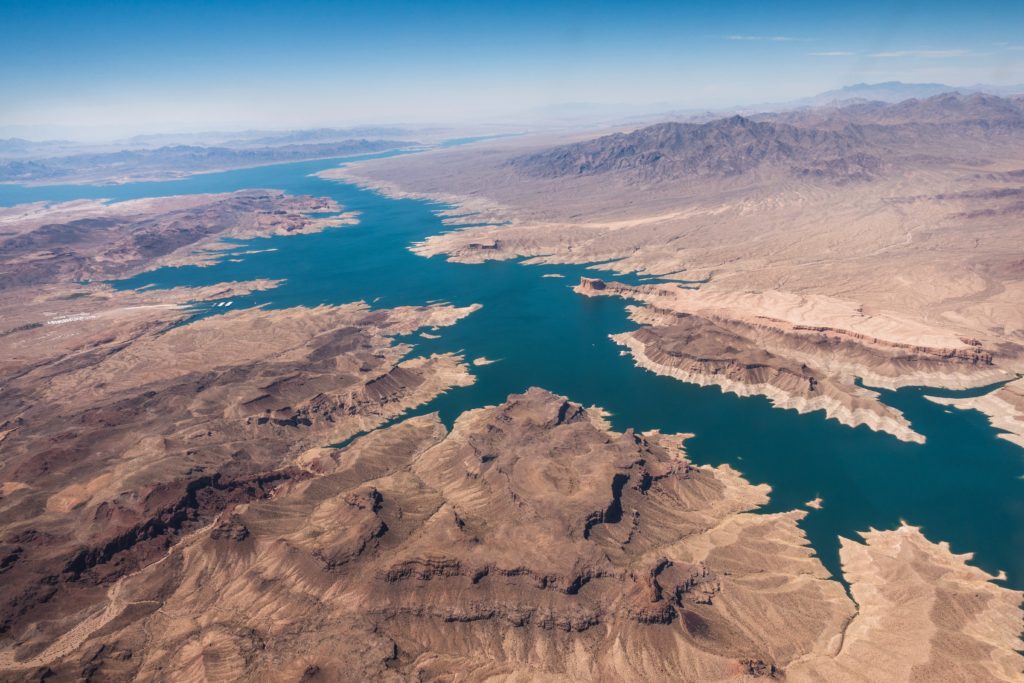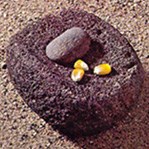
- BOATING Boating on Lake Mead and Lake Mohave is one of the more popular activities here. With more than 290 square miles of waterway to navigate, boaters can enjoy the thrill of open water or relax in a private cove. But boating also has its rules and regulations. This page covers everything you need to know to have a fun and safe time boating on the lakes, along with details about the park’s many launch ramps and boat rental locations.
- Fishing is a favorite pastime here at Lake Mead National Recreation Area. With more than 290 square miles of water surface, you can be sure to find a favorite spot to catch the big one. Lake Mead has become famous for its striped bass with an occasional catch weighing in at over 40 pounds. Popular fish include rainbow trout, catfish, sunfish, largemouth bass, striped bass, smallmouth bass and crappie. Rainbow Trout are routinely released near Willow Beach on Fridays. Keep in mind that our park lies within two states and each has their own specific fishing regulations. We have provided information below to help you have a fantastic fishing experience.
- SUBA DIVING Lake Mead National Recreation Area, which includes Lake Mead and Lake Mojave, is often highlighted as one of the top freshwater lakes in the world for scuba diving. The lakes offer a range of depths and submerged sites for both novice and technical divers. Please note that fluctuating lake water constantly changes dive location conditions
- CAMPING Spend your next camping adventure on the lake. With over 900 camping and RV sites at 15 different locations, there is a variety of desert and lakeside landscapes sure to please everyone. Lake Mead National Recreation Area’s campgrounds offer restrooms, running water, dump stations, grills, picnic tables and shade. RV’s, trailers and tents welcome. Concessioner campgrounds, including recreational vehicle hook-ups, are also available within the park.
- HIKING
Although most visitors are attracted to Lake Mead National Recreation Area because of lakes Mead and Mohave, more than 87% of the park protects a vast area of the eastern Mojave Desert. Perhaps the best way to explore this diverse ecosystem is on foot, traveling across open expanses of rock formations that contain all the colors of the rainbow.
Here, canyons and washes abound, offering a challenge to even the most experienced hiker. The best season for hiking is November through March when temperatures are cooler. Hiking during the day time in the summer months is not recommended because temperatures can reach 120 degrees F in the shade. Ranger-guided hikes are offered year round, with those in the summer months being held in the evenings.
LAKE MEAD HISTORY AND CULTURE
Before the existence of Lake Mead, Lake Mohave, and Hoover Dam, the area encompassing the one and a half million acres of the Lake Mead National Recreation Area was occupied by early desert Indian cultures, adventurous explorers, ambitious pioneers looking for cheap land and religious freedom, and prospectors seeking riches. Based on archaeological evidence, several Native American cultures have been identified as having existed 8,000 to 10,000 years ago in an environment wetter and cooler than it is today. These cultures hunted game, gathered local edible plants and practiced farming. In a cave near present-day Lake Mead, the remains of large mammals were discovered by archaeologist Mark R.Harrington and paleontologist James Thurston including: ground sloth (Nothrotheriops shastensis), horse (Equus sp.), camel (Camelops sp.) and mountain sheep (Ovis canadensis). Notches found on the bones of animals located in that primitive dwelling show evidence that they were prepared and eaten by humans.  Metate, Mano, and Corn Kernels Various prehistoric culture groups made the Colorado River region their home. Archaeological investigations have provided evidence that some were hunter/gatherers and lived in caves; other groups lived in pit houses and Puebloan-type structures, and practiced early farming. Ranging from present day Davis Dam north to the Virgin and Muddy Rivers, these early farming groups grew corn, beans, squash and cotton. Metate, Mano, and Corn Kernels Various prehistoric culture groups made the Colorado River region their home. Archaeological investigations have provided evidence that some were hunter/gatherers and lived in caves; other groups lived in pit houses and Puebloan-type structures, and practiced early farming. Ranging from present day Davis Dam north to the Virgin and Muddy Rivers, these early farming groups grew corn, beans, squash and cotton.  Amargosa Projectile Point Their technology included pottery of the reddish-brown and gray-brown buff ware with simple black and red decoration. They ground corn and seeds with manos and metate and hunted game with spears, bows & arrows made from local or traded materials. Early explorers traveling from Utah to California crossed through the region over land and water. In search of areas rich in animal furs for trade, Jedediah Smith traversed the Virgin and Colorado rivers in 1826 and 1827, encountering the early Indians who lived along the river banks. Amargosa Projectile Point Their technology included pottery of the reddish-brown and gray-brown buff ware with simple black and red decoration. They ground corn and seeds with manos and metate and hunted game with spears, bows & arrows made from local or traded materials. Early explorers traveling from Utah to California crossed through the region over land and water. In search of areas rich in animal furs for trade, Jedediah Smith traversed the Virgin and Colorado rivers in 1826 and 1827, encountering the early Indians who lived along the river banks.  In 1855, Lt. Joseph Christmas Ives traveled the lower Colorado River in search of safe and efficient passage upon the steamship, Explorer. Following Ives, John Wesley Powell continued exploration of the upper Colorado River from the Grand Canyon to where it meets the Virgin River. Powell became a noted historian of the region. In 1855, Lt. Joseph Christmas Ives traveled the lower Colorado River in search of safe and efficient passage upon the steamship, Explorer. Following Ives, John Wesley Powell continued exploration of the upper Colorado River from the Grand Canyon to where it meets the Virgin River. Powell became a noted historian of the region.  “I would defy anyone to make a journey by boat through those still, weird chasms and down that yet mysterious River, and not be brought under by their influence.” – John Wesley Powell, 1893 talking about the Colorado River through the Black Canyons Read about Powell’s experience in Down the Great Unknown: John Wesley Powell’s 1869 Journey of Discovery and Tragedy through the Grand Canyon by Edward Dolnick. The southwestern desert with its arid environment was a most inhospitable environment in which to live. For centuries the early native inhabitants living along the Colorado River found innovative ways to irrigate small agricultural plots. The region became more and more populated by white settlers with the advent of rail transportation and the discovery of gold and silver in the mountains of southern Nevada. Mormon pioneers established communities and prospectors established mining claims up and down the river. Visionaries desiring continued westward expansion sought to discover ways to harness the power of the river to allow for large-scale irrigation and other industries. Thus, the concept of building a dam was born. The Reclamation Act of 1902 thus instituted the construction of Boulder Dam, later to be named Hoover Dam which began in1931.The reservoir created by the damming of the Colorado River became Lake Mead, named after Elwood Mead, the Bureau of Reclamation commissioner at the time. The newly formed lake drew thousands of visitors to this wondrous contrast of desert and water. Lake Mead National Recreation Area became the first national recreation area in 1964. Today, millions of visitors each year come to enjoy the many recreational opportunities found within the park’s diverse landscape. “I would defy anyone to make a journey by boat through those still, weird chasms and down that yet mysterious River, and not be brought under by their influence.” – John Wesley Powell, 1893 talking about the Colorado River through the Black Canyons Read about Powell’s experience in Down the Great Unknown: John Wesley Powell’s 1869 Journey of Discovery and Tragedy through the Grand Canyon by Edward Dolnick. The southwestern desert with its arid environment was a most inhospitable environment in which to live. For centuries the early native inhabitants living along the Colorado River found innovative ways to irrigate small agricultural plots. The region became more and more populated by white settlers with the advent of rail transportation and the discovery of gold and silver in the mountains of southern Nevada. Mormon pioneers established communities and prospectors established mining claims up and down the river. Visionaries desiring continued westward expansion sought to discover ways to harness the power of the river to allow for large-scale irrigation and other industries. Thus, the concept of building a dam was born. The Reclamation Act of 1902 thus instituted the construction of Boulder Dam, later to be named Hoover Dam which began in1931.The reservoir created by the damming of the Colorado River became Lake Mead, named after Elwood Mead, the Bureau of Reclamation commissioner at the time. The newly formed lake drew thousands of visitors to this wondrous contrast of desert and water. Lake Mead National Recreation Area became the first national recreation area in 1964. Today, millions of visitors each year come to enjoy the many recreational opportunities found within the park’s diverse landscape. |
Information from the National Parks Service website.

